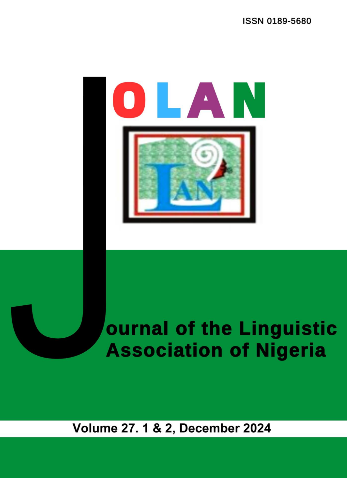Ethnosemiotic significance of leaves among the Efik in South-Eastern Nigeria
DOI:
https://doi.org/10.60787/jolan.vol27no1-2.402Keywords:
Botanical Signifier, Ethnosemiotics, Identity, Leaves, Cultural CommunicationAbstract
Communication by means of objects is an important facet of visual communication which is within the broader spectrum of multimodal communication. Among the Efik people in Cross River State, South-eastern Nigeria, tropical leaves have wide ranging communicative functions. This article explores the ethnosemiotic significance of eight tropical leaves and discusses the ways they have been conventionalized and used as traditional modes of communication. Data were collected through participant observation and semi-structured interviews from 25 participants who were purposively sampled based on their deep knowledge of leaves with communicative import. The study is rooted in ethnosemiotic methods and principles which explain how people make meaning out of symbols and how they are interpreted based on their culture-related semiotic codes and structure. The study discovers that tropical leaves among the Efik can be used to signal prohibition, demarcate boundaries, indicate bereavement, enact solidarity, and resolve conflicts. The research concludes that these leaves provide yet another element in understanding the dynamics of cultural communication, and illuminate their social relevance in the larger sociocultural fabrics of the Efik society, particularly as a framework of indigenous knowledge system. The study is vital to the construction and preservation of traditional communication systems and cultural identity.
References
Adnan, N. and Othman, N. (2012). The relationship between plats and the Malay culture. Procedia: Social and Behavioural Sciences, 42, 231-241.
Ashton M (2018) Communicating through objects: Facilitating qualitative research in design. Oxford University Press.
Balick, M. & Cox, P. A. (2020). Plant. People and culture: The science of ethnobotany. New York: Taylor and Francis.
Barker, C. (2012) Cultural studies. London: Sage.
Burgoon, J., Guerrero, L. & Floyd, K. (2016). Introduction to non-verbal communication. In Burgoon, J., Guerrero, L. & Floyd, K. (Eds.), Non-verbal Communication (pp. 1-25). Routledge.
Chaachouay, N., and Zidane, L. (2021). The Symbolic Efficacy of Plants in Rituals and Socio-Religious Ceremonies in Morocco, Northwest of Africa. Journal of Religious & Theological Information, 21(1–2), 34–53.
Chahal, K. (2021). Economic importance of different classes of plants. Krishna Publication House.
Chandler, D. (2022). Semiotics. Routledge.
Connell, B. (1994) The lower-cross languages: A prolegomena to the classification of Cross River Languages. Journal of West African Languages, 24(1), 3-46.
de Saussure F (1959) A course in general linguistics. Philosophical Library Faraclas, N. (1989) The Cross River languages. In Bendor-Samuel J. (Ed.), The Niger-Congo languages (pp. 277-294). University Press of America.
Feldman A (1999) The role of conversation in collaborative action research. Education Action Research, 7(1), 25-147.
Felzer, B., Cronin, T., Reilly, J., Melillo, J. & Wang, X. (2007). Impacts of ozone on trees and crops. Comptes Rendus Geoscience, 339(11-12), 784-798.
Gairola, S., Singh, K., & Sharma, J. (2022). Plants used for socio-magico-reliious purposes by the indigenous communities of Sub-Himalayan Tract, Uttarakhand. Ethnobotany Research and Applications, 23, 1–19.
Greimas A. & Courtés J. (1982) Semiotics and language: An analytical dictionary. Indiana University Press.
Grouchy, P., D’Eleuterio, G., Christiansen, M. & Lipson, H. (2016). On the evolutionary origin of symbolic communication. Scientific Reports 6, 34615 https://doi.org/10.1038/srep34615.
Haviland, W., Prins, H. & McBride, B. (2013). Cultural anthropology: The human challenge. Cengage Learning.
Hoppál, M. 1988. Ethnosemiotics and semiotics of culture. In Broms, H. & Kaufmann, R. (Eds.), Semiotics of culture (pp.17–33). Suomalaisen Kirjallisuuden Seura.
Johnson, J. & Weller, S. (2001) Elicitation techniques for interviewing. In Gubrium, J. & Holstein, J. (Eds.), Handbook for interview research: Contexts and methods. (pp. 49-63). Thousand Oaks.
Kora, A. (2019). Leaves as dinning plates, food wraps ad food packing materials: Importance of renewable resource in Indian culture. Bulletin of National Research Centre 43:205. https://doi.org/10.1186/s42269-019-0231-6
Kress, G. & van Leeuwen, T. (1996). Reading images: The grammar of visual design. Routledge.
Kumar, R., Bisht, M., Shah, Z., Bisht, M. & Arya, D. (2013). Sacred plants used by locals in religious ceremonies and rituals in Western region of Kurnaun Himalaya. International Journal of Botany Studies, 8(3), 12-17.
Lee, D. (2020). The role of plants in drugs and medicine. Accessed August 2, 2024.
https://www.openaccessgovernment.org/the-role-of-plants-in-drugs-and-medicines/98286/
MacCannell, D. (1979) Ethnosemiotics. Semiotica 27(1/3), 149-172.
Mathers, J. (2006). Plant food for human health: Research challenges. Proceedings of the Nutritional Society, 65(2), 198-203.
Mensah, E. O. (2002) Writing and literacy development: A linguistic evaluation. Global Journal of Humanities 2(1), 51-68.
Mensah, Eyo. (2023). The appropriation of animal names as personal names in Ibibio and Tiv onomastic traditions in Nigeria: An ethnopragmatic study. In Ndlovu, Sambulo (ed). Personal names and naming from an anthropological-linguistic perspective. 217- 238. Amsterdam: De Gruyter.
Mensah, E. (2008). Efik morphology: A study of word structure in generative grammar. PhD Thesis, University of Calabar
Mensah, E. 2015. Frog, where are you? The ethnopragmatics of Ibibio death prevention names. Journal of African Cultural Studies 27(2), 115-132.
Mensah, E. O & Vivian Dzokoto, V. 2023. Melting intestines, red hearts, and scattering eyes: Exploring embodiment in the Efik feeling lexica. Journal of African Languages and Linguistics 44(1), 49-75.
Nature (2018). The roots of culture. Nature Plants 4, 735. .https://doi.org/10.1038/s41477-018-0285-8
Orr, L. (1986). Intertextuality and cultural text in recent semiotics. College English, 48(8), 811–823.
Parish, J. (2011) West African witchcraft, wealth and moral decay in New York City. Ethnography, 12(2), 247-265.
Quiroz, D. & van Andel, T. (2018). The cultural importance of plants in Western African religions. Economic Botany, 72, 251-262.
Rizal, K., Faradilla, M., Aswadi, K., Hidayat, R. & Saputra, D. (2024). Encouraging communities creativity in utilizing Betel leaf as a traditional Aceh wedding ornament. International Review of Community Engagement, 1(1), 1-5.
Sari, N., Sarjani, N. & Narulita, E. (2024). The culture of packaging traditional Balinese snacks with banana leaves. Advances in Social Science, Education and Humanities Research, 778, 1538-1547.
Schaal, B. (2019). Plants and people: Our shared future. Plant, People and Planet 14-19.
Schiffer, M. (1999) Behavioural archaeology: Some classifications. American Antiquity, 64(1), 166-168.
Shoemaker, C. (2010). Plants and human culture. Journal of Home and Consumer Horticulture, 1(2-3), 3-7.
Smith, K., Moriarty, S., Kenney, K. and Barbatsis, G. (Eds). (2004) Handbook of visual communication: Theory, method and media. Routledge.
Sofowora, A, Ogunbodede, E., & Onayade, A. (2013). The role and place of medicinal plants in the strategies for disease prevention. African Journal of Traditional Complementary and Alternative Medicine, 10(5), 210-29.
Stano, S. (2014). Eating the other. A semiotic approach to the translation of the culinary code. PhD Thesis. Università di Torino and Università della Svizzera Italiana.
Stasch, R. (2008). Referent-wrecking in Korowai: A New Guinea abuse register as ethnosemiotic protest. Language in Society, 37, 1-25.
Ukwubile, C., Ikpefan, E., Dibal, M., Umeano, V., Menkiti, D., Kaosi, C., Ademola, S., Famurewa, C., Nettey, H., & Yerima, T. (2023). Pharmacognostic profiles, evaluation of analgesic, anti-inflammatory and anticonvulsant activities of Newbouldia laevis (P. Beauv.) Seem. ex Bureau leaf and root extracts in Wistar rats. Ethnopharmacology doi: 10.1016/j.jep.2023.116632.
Umiker-Sebeok, J. (1977). Semiotics of culture: Great Britain and North America. Annual Review of Anthropology 6, 121–135.
Weber, S. (2008). Visual images in research. In Knowles, G. J. and Cole, A. L. (Eds.), Handbook of arts in qualitative research: Perspectives, methodologies, examples and issues. (pp. 41-54). Sage.
Williamson, K. & Blench, R. (2001) Niger-Congo. In Heine, B. and Nurse, D. (Eds.), African languages: An introduction (pp. 11-42). Cambridge University Press.
Downloads
Published
How to Cite
Issue
Section
License
Copyright (c) 2025 Journal of The Linguistic Association of Nigeria

This work is licensed under a Creative Commons Attribution-NonCommercial-ShareAlike 4.0 International License.













